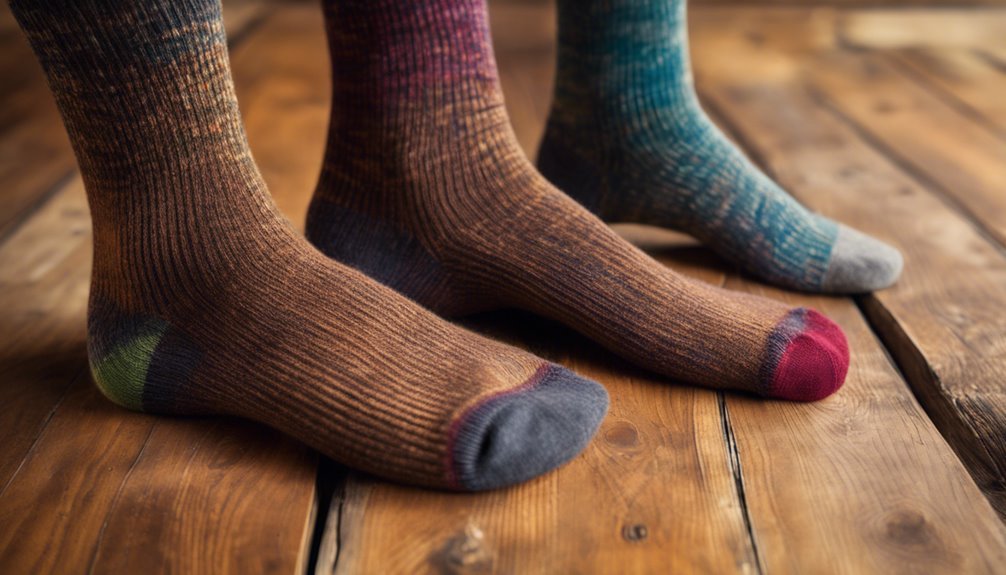Wool Dress Socks vs. Cotton Dress Socks: Which Is More Breathable?
When comparing wool and cotton dress socks for breathability, wool generally excels due to its natural moisture-wicking abilities and thermal regulation. Wool effectively manages sweat and maintains a comfortable temperature, keeping your feet dry in varying conditions. Cotton is breathable but tends to retain moisture, which may lead to dampness. If you're interested in the specific properties and benefits of each material, you'll find valuable insights to help you make an informed choice.
Understanding Wool: Properties and Benefits

While you may be familiar with wool's traditional use in winter garments, its properties and benefits extend far beyond mere warmth, making it an excellent choice for dress socks. Wool characteristics include natural elasticity, moisture-wicking ability, and thermal regulation. This means that wool can stretch without losing shape, effectively manage moisture, and maintain a comfortable temperature, even in varying conditions. Additionally, wool fibers possess natural anti-bacterial properties, reducing odor and promoting freshness. The breathability of wool allows for airflow, preventing overheating and ensuring comfort throughout the day. By choosing wool dress socks, you're not just selecting a product for warmth; you're opting for enhanced durability, comfort, and freedom of movement, all of which contribute to a superior wearing experience.
Understanding Cotton: Properties and Benefits
When considering cotton's role in dress socks, it's important to understand its fiber composition and moisture absorption properties. Cotton fibers, primarily composed of cellulose, provide a soft texture and breathability that enhances comfort. Additionally, their ability to absorb moisture helps keep your feet dry, making cotton a practical choice for daily wear.
Cotton Fiber Composition
Cotton, a versatile and widely used textile fiber, boasts a unique composition that contributes to its popularity in apparel, particularly in dress socks. Understanding the different cotton fiber types helps you appreciate their distinct characteristics and performance. Here are some key points to reflect upon:
- Natural Fiber: Cotton is a natural fiber, offering comfort and breathability.
- Variety of Types: Different cotton fiber types, like Egyptian and Pima, provide varying softness and durability.
- Cotton Blend Advantages: Blending cotton with synthetic fibers can enhance stretch and moisture-wicking properties.
- Sustainability: Cotton is biodegradable, making it an eco-friendly choice for conscious consumers.
Moisture Absorption Properties
Understanding the composition of cotton reveals its impressive moisture absorption properties, which greatly enhance its suitability for dress socks. Cotton fibers can absorb up to 27 times their weight in moisture, offering excellent moisture retention. This ability helps keep your feet dry and comfortable throughout the day. Unlike wool, which can retain moisture and become heavy, cotton dries quickly, improving its drying speed. This characteristic is particularly beneficial in warmer climates, where you want to avoid dampness. Additionally, cotton's breathability guarantees that any moisture evaporates efficiently, preventing unpleasant odors. To summarize, if you value comfort and seek to maintain foot health, cotton dress socks provide a practical choice with superior moisture management.
Moisture Management: How Wool Handles Sweat
When it comes to moisture management, wool excels through its natural moisture-wicking properties, efficiently drawing sweat away from your skin. This feature not only keeps your feet dry but also contributes to wool's inherent odor resistance, making it a practical choice for all-day wear. Understanding how these characteristics work can help you make an informed decision between wool and cotton dress socks.
Natural Moisture Wicking
Although both wool and cotton have their merits, wool's natural moisture-wicking properties set it apart, particularly in dress socks. Wool fibers can absorb significant amounts of natural moisture while still feeling dry to the touch, allowing for superior moisture management. This is essential for maintaining comfort throughout your day.
Key benefits of wool's natural moisture-wicking properties include:
- Rapid moisture absorption: Quickly pulls sweat away from your skin.
- Quick-drying capability: Keeps your feet feeling dry in various conditions.
- Temperature regulation: Helps maintain a comfortable temperature regardless of the environment.
- Enhanced comfort: Reduces the likelihood of dampness, promoting overall foot health.
Choosing wool dress socks means investing in a more breathable, comfortable experience.
Odor Resistance Properties
Wool's moisture-wicking abilities not only keep your feet dry but also contribute greatly to its odor resistance properties. This natural fiber excels in odor control due to its unique structure, which absorbs moisture away from your skin, preventing sweat accumulation. When sweat is absorbed, it reduces the conditions that foster bacteria growth, enhancing bacteria resistance. Unlike cotton, which can trap moisture and promote odor, wool maintains a drier environment, markedly reducing unpleasant smells. Additionally, wool's inherent lanolin content offers antimicrobial properties, further combating odor. By choosing wool dress socks, you're investing in a solution that not only manages moisture but also keeps your feet feeling fresh, allowing you the freedom to move confidently throughout your day.
Moisture Management: How Cotton Handles Sweat
While cotton is often praised for its softness, it also plays an essential role in moisture management when it comes to dress socks. Its properties allow it to effectively handle sweat, making it a popular choice for many. Here's how cotton excels in moisture management:
- Moisture Absorption: Cotton fibers absorb moisture, drawing sweat away from your skin.
- Sweat Evaporation: The breathable nature of cotton allows for quick evaporation of absorbed moisture.
- Comfort: This absorption and evaporation process keeps you feeling dry and comfortable throughout the day.
- Versatility: Cotton socks can be worn in various settings, from formal occasions to casual outings.
Understanding these qualities helps you appreciate cotton's role in keeping your feet feeling fresh, especially in warmer conditions.
Temperature Regulation: Wool's Natural Insulation
When considering dress socks for varying temperatures, one cannot overlook the exceptional insulation properties of wool. Wool insulation works by trapping air within its fibers, creating a barrier against cold and heat. This natural structure allows for effective temperature control, keeping your feet warm in winter and cool in summer. Unlike synthetic materials, which can lead to overheating, wool's breathability enables moisture to escape, further enhancing comfort. When you choose wool dress socks, you're investing in a versatile option that adapts to your body's needs, ensuring your feet remain comfortable throughout the day. Whether at the office or out socializing, the effective temperature regulation of wool helps maintain a balanced environment for your feet.
Temperature Regulation: Cotton's Breathability

Cotton dress socks excel in breathability, making them a popular choice for those seeking comfort in warmer conditions. The cotton breathability benefits allow for effective temperature regulation, ensuring your feet stay cool and dry. This material's natural ability to wick moisture away from the skin combats sweat and prevents discomfort.
- High airflow reduces heat buildup.
- Enhanced moisture retention helps keep feet dry.
- Lightweight fabric minimizes bulk, enhancing comfort.
- Versatile for various occasions, from casual to formal.
When you slip on cotton dress socks, you can enjoy the freedom of movement and breathability, allowing your feet to remain fresh throughout the day. These features make cotton an excellent option for those who prioritize comfort and functionality.
Durability: Comparing Wool and Cotton Dress Socks
When it comes to durability, wool and cotton dress socks differ markedly in fiber strength and resistance to wear and tear. Wool fibers are naturally stronger and more resilient, making them less prone to damage over time. In contrast, cotton tends to wear out faster, especially in high-friction areas, which can impact its longevity.
Fiber Strength Comparison
Although both wool and cotton are popular choices for dress socks, their fiber strength plays an essential role in determining durability. When you're deciding between the two, consider the following aspects of fiber durability and fiber elasticity:
- Wool: Naturally resilient, offering excellent elasticity and shape retention.
- Cotton: While soft, it tends to wear out faster under stress due to lower elasticity.
- Wool's resistance: It can withstand heavy use without losing integrity.
- Cotton's limitations: More prone to fraying and breaking down over time.
Ultimately, if you value durability in your dress socks, wool often emerges as the stronger option. By understanding these differences, you can make a more informed choice for your wardrobe needs.
Wear and Tear Resistance
While both wool and cotton dress socks serve their purpose, their wear and tear resistance varies considerably due to their inherent properties. Wool generally exhibits superior wear resistance, thanks to its natural elasticity and crimp, which help maintain shape over time. Cotton, while comfortable, tends to show signs of wear faster, particularly in high-friction areas.
| Material | Wear Resistance | Tear Strength |
|---|---|---|
| Wool | High | High |
| Cotton | Medium | Medium |
Comfort Levels: Wool vs. Cotton Against the Skin
Choosing between wool and cotton dress socks can greatly impact your comfort throughout the day, as each material offers distinct sensations against the skin. Wool typically provides a softer, more luxurious feel, enhancing skin comfort, while cotton boasts a lightweight texture that's often cooler.
Consider these factors when evaluating sock texture:
- Wool: Naturally moisture-wicking and insulating, maintaining temperature.
- Cotton: Breathable and lightweight, ideal for warmer environments.
- Wool blends: Combine the best of both worlds for enhanced comfort.
- Cotton blends: May offer additional durability and softness.
Ultimately, your choice should reflect your personal comfort preferences, allowing for freedom of movement while keeping your feet feeling great throughout the day.
Care and Maintenance: Keeping Your Socks in Top Shape
Proper care and maintenance are essential for extending the lifespan of your dress socks, whether they're wool or cotton. For ideal durability, consider these socks storage and washing techniques:
| Care Aspect | Wool Socks |
|---|---|
| Washing Technique | Hand wash or gentle cycle cold |
| Storage Method | Lay flat or roll, avoid hanging |
| Care Aspect | Cotton Socks |
| Washing Technique | Machine wash warm, tumble dry |
| Storage Method | Fold neatly, keep in drawer |
Using the right washing techniques prevents shrinking and maintains shape. Proper socks storage keeps them in prime condition, ensuring you enjoy their comfort and breathability for longer. Make these practices a habit, and your socks will thank you!
Choosing the Right Sock for Different Occasions

How do you determine the right sock for each occasion? Selecting the appropriate sock can enhance your comfort and style. For formal events, opt for wool dress socks; they provide breathability and a polished look. Conversely, for casual outings, cotton socks offer flexibility and comfort.
Consider these factors when choosing socks:
- Material: Wool for formality; cotton for casual wear.
- Length: Ankle socks for relaxed settings; crew or dress socks for formal occasions.
- Color: Darker shades for business or formal; lighter and vibrant colors for casual settings.
- Functionality: Look for moisture-wicking properties in warmer climates.
Your sock choice can greatly impact your overall outfit, so make it count!
Frequently Asked Questions
Can I Wear Wool Socks in Summer?
Yes, you can wear wool socks in summer. Their natural breathability helps regulate temperature, ensuring summer comfort. Merino wool, in particular, wicks moisture effectively, keeping your feet dry and comfortable even in warmer weather.
Are Cotton Socks Better for Sensitive Skin?
When considering sensitive skin benefits, cotton socks often provide comfort and breathability. However, if you have cotton allergy concerns, it's essential to choose hypoallergenic options to guarantee your skin remains irritation-free and comfortable.
How Do I Wash Wool Dress Socks?
To wash wool dress socks, use gentle washing techniques—either hand wash or cold machine cycle. Always choose mild detergent and avoid fabric softeners; proper sock care extends their lifespan and maintains comfort during wear.
Do Wool Socks Cause Itching?
Imagine a knight donning armor; wool socks can sometimes cause irritation due to their fibers. However, many find them comfortable. If you're sensitive, consider blends or softer wool to enhance your sock comfort without the itch.
Are Dress Socks Available in Blends of Wool and Cotton?
Yes, you'll find dress socks available in both wool blends and cotton blends. These combinations offer enhanced comfort, breathability, and moisture-wicking properties, catering to your need for versatility while maintaining a refined style in your wardrobe.






